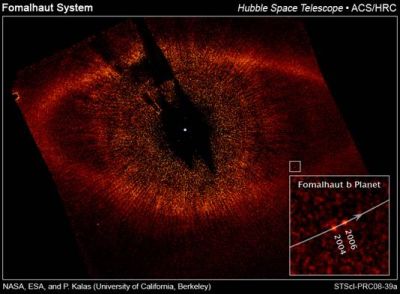15 November 2008

Astronomers using NASA's Hubble Space Telescope (HST) have taken the first visible-light images of a planet orbiting another star. The images show the planet as a tiny point source of light, near its bright parent star, known as Fomalhaut فم الحوت. The Fomalhaut system is located 25 light-years away, in the constellation Piscis Australis الحوت الجنوبي. The planet is designated Fomalhaut b; the star’s name comes from Arabic.
The light year is a unit of measuring stellar distances. It is equal to 9.46 × 1012 km, or approximately 10,000 billion km.
An immense disk of cosmic debris surrounds Fomalhaut. The distance of Fomalhaut b from its star is approximately 17 billion km or over 100 times the average Sun-Earth distance. Computations show that Fomalhaut b completes an orbit around Fomalhaut every 872 years. Planets orbiting other stars are termed exoplanets or extrasolar planets.
The inset at bottom right of image is a composite image showing the planet's position during Hubble observations made in 2004 and 2006.
The white dot in the center of the image marks the location of Fomalhaut. As Fomalhaut b is much fainter than Fomalhaut, the researchers blocked out Fomalhaut's bright glare, applying a special technique, in order to reveal the dim planet. Therefore, the region around Fomalhaut's location is dark. The radial streaks are scattered starlight. The red dot at lower left is a distant background star.
Fomalhaut is larger and hotter than the Sun. Its diameter is 1.8 times the solar diameter, and its surface temperature is nearly 9,000 C (the Sun’s surface temperature is approximately 5,800 C). Fomalhaut is estimated to be “only” 200 million years old. By the cosmic time scale standards, it is much younger than the Sun, believed to have formed 4,500 million years ago!!
Further Reading
NASA’s Press Release
http://hubblesite.org/newscenter/archive/releases/2008/39/text/
Planet Quest
http://planetquest.jpl.nasa.gov/
Aymen Mohamed Ibrahem
Senior Astronomy Specialist